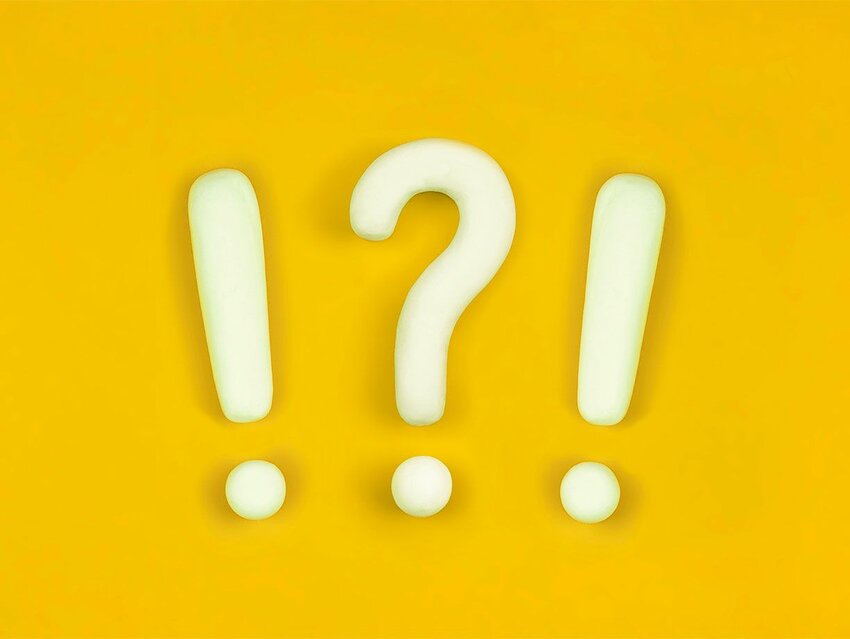Punctuation marks have been around for thousands of years. Some of the earliest punctuation originated in Greek and Latin texts during the classical period, and the word itself comes from the Latin term punctus, meaning “point.” We know the usual suspects — periods, commas, exclamation points, question marks, and the like — but sometimes we need a little more color. Whether you’re trying to convey sarcasm, excitement, or just taking a pause, these rarer punctuation marks are worth knowing.
⁂ Asterism
Made of three asterisks, this starry symbol has multiple uses. Writers can use an asterism to draw attention to a specific section or use it to divide chapters, verses, or other elements. It can also indicate a footnote in more formal settings. It gets its name from astronomy, in which a small group of stars is called an asterism. It’s an uncommon typographic mark, but it can still be found in most word-processing software. In a triangle formation, it’s an “asterism,” but if the three stars are in a horizontal formation, it’s called a “dinkus.”
«Guillemets»
Guillemets are quotation marks in the French language (and sometimes in other European languages). We’re including them in our “lesser-known punctuation marks” article, but if you set your keyboard to a French setting, guillemets would replace quotation marks. They were created by French typecutter Guillaume Le Bé in the 16th century, who named them after himself. “Guillaume” is a French variation of the English name “William,” which means “guillemets” roughly translates to “little Williams.”
❧ Hedera
The hedera was first used in Greek and Latin to separate paragraphs in longer texts. It looks like a floral heart and gets its name from the Latin word meaning “ivy.” It’s also called a “fleuron,” which came from the Old French word for flower, “floron.” Eventually, the hedera turned into an ornamental symbol; now, it's barely used at all.
Interrobang‽
Here’s a two-for-one: The interrobang is a question mark that is used at the end of an exclamatory question, combining both punctuation marks into one easy-to-use symbol (‽). It can also be replaced by a “?!” or a “!?” if the interrobang symbol is not available. Usually, the question will be rhetorical, like when a singer demands, “Are you ready to rock‽” The interrobang is relatively new — the portmanteau has only been around since the 1960s. “Interro” is short for “interrogation point” (the technical term for a question mark), and “bang” is printer’s slang for an exclamation point.
☞ Manicule
This punctuation gets straight to the point. For centuries, it was used in the margins of books to point out a particularly useful or important piece of the text. Its name comes from the Latin word “manicula,” meaning “little hand.” It’s difficult to determine the first use of the symbol, but it was mainstream in Europe by the 12th century.
Percontation Point⸮
“Percontation” is an obsolete word describing an “act of questioning.”In the Middle Ages, this mark was used at the end of a rhetorical question. William Shakespeare could have used the percontation point in The Merchant of Venus when he wrote, “If you prick us, do we not bleed⸮” Wouldn’t a lot of confusing text exchanges get cleared up if the percontation point was brought back from the punctuation graveyard⸮
¶ Pilcrow
A pilcrow is an indicator of a new paragraph, although it’s rarely used today. It comes from the Middle English word “pylcrafte,” which had the same meaning. It also goes by the names “blind P” and “alinea.” It’s still used in word processors today, or in legal documents to cite a certain paragraph, as in, “Please refer to ¶12.” Before this fancy-looking symbol was put into place, writers experimented with other symbols to indicate a new paragraph. One popular choice was a “K,” which stood for the Latin word “kaput,” meaning “head.”
§ Silcrow
This symbol is also called a “section sign” and does exactly as its name suggests; it denotes a citation by section number or letter. For example: “Please refer to document B, § 145.” Its double “S” shape stands for “signum sectionis” in Latin. The shape originated with old scribes whose handwriting varied, resulting in an abstract-looking double “S.”
Snark Mark.~
As its name suggests, a snark mark allows an author to convey sarcasm. It consists of a regular period at the end of a sentence, followed by a tilde (a type of accent symbol commonly used in Spanish). It’s relatively new as far as punctuation marks go: Typographer Choz Cunningham came up with it in 2007 as a way to better indicate verbal irony. For example, coming into the office during a downpour and sending out an email saying, “Lovely weather we’re having today.~” is a great use of a snark mark.
Featured image credit: SaskiaAcht/ iStock

